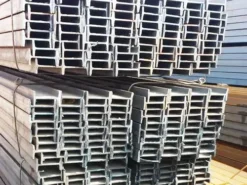-Channel steel Introduction:
Channel is a long steel material with a channel-shaped cross-section. It is a type of carbon structural steel used in construction and machinery. It is a type of steel with a complex cross-section and a groove-shaped cross-section. Channel steel is mainly used in building structures, curtain wall engineering, mechanical equipment and vehicle manufacturing. Good welding, riveting performance and comprehensive mechanical properties are required during use. The raw material billets for the production of channel steel are carbon steel or low alloy steel billets with a carbon content of no more than 0.25%. Finished channel steel is delivered in hot-formed, normalized or hot-rolled condition. Specifications are expressed in millimeters of waist height (h) * leg width (b) * waist thickness (d). For example, 100*48*5.3 means the waist height is 100 mm, the leg width is 48 mm, and the waist thickness is 5.3 mm. Steel, or 10# channel steel. For channel steel with the same waist height, if there are several different leg widths and waist thicknesses, you need to add a bc on the right side of the model to distinguish, such as 25#a 25#b 25#c, etc.
-Classification:
Channel steel is divided into ordinary channel steel and light channel steel. The specifications of hot-rolled ordinary channel steel are 5-40#. The specifications of hot-rolled modified channel steel supplied by agreement between the supplier and the buyer are 6.5-30#. Channel steel is mainly used in building structures, vehicle manufacturing, other industrial structures and fixed panels. Channel steel is often used in conjunction with I-beams.
Channel steel can be divided into 4 types according to shape: cold-formed equal-edge channel steel, cold-formed unequal-edge channel steel, cold-formed inner curled channel steel, and cold-formed outer curled channel steel.
-Specifications:
The specifications of channel steel are mainly expressed by height (h), leg width (b), waist thickness (d) and other dimensions. The specifications of domestic channel steel range from 5 to 40, that is, the corresponding height is 5 to 40cm.
At the same height, light channel steel has narrower legs, thinner waist and lighter weight than ordinary channel steel. No. 18 to 40 are large channel steels, and No. 5 to 16 are medium channel steels. Imported channel steel is marked with actual specifications, dimensions and related standards. The import and export orders of channel steel are generally based on the specifications required for use after determining the corresponding carbon steel (or low alloy steel) steel grade. Apart from specification numbers, channel steel does not have a specific composition and performance series.
The delivery length of channel steel is divided into two types: fixed length and double length, and the tolerance value is specified in the corresponding standard. The length selection range of domestic channel steel is divided into three types according to different specifications: 5-12m, 5-19m, and 6-19m. The length selection range of imported channel steel is generally 6-15m.
-Theoretical Weight
5#: 50*37*4.5=5.438kg/m
6.3#: 63*40*4.8=6.634kg/m
6.5#: 65*40*4.3=6.709kg/m
8#: 80*43*5.0=8.045kg/m
10#: 100*48*5.3=10.007kg/m
12#: 120*53*5.5=12.059kg/m
….40#
-Allowable deviation(mm):
Height h ±1.5 ±2.0 ±2.0 ±3.0 ±3.0
Leg width b ±1.5 ±2.0 ±2.5 ±3.0 ±3.5
Waist thickness d ±0.4 ±0.5 ±0.6 ±0.7 ±0.8
The bending deflection should not exceed 0.15d
Usually length 5 ~ 12m 5 ~ 19m 6 ~ 19m
-Chemical composition inspection:
Composition index. Channel steel belongs to the series of rolled steel for structural use. The main indicators for chemical composition inspection are C, Mn, P, and S. The manufacturing steel numbers of domestic channel steel are Q235A, Q235B, Q295A, and Q345A. wait. The manufacturing steel grades of imported channel steel mainly include SS400, SS490 (Japanese Industrial Standard), St44-3, St52-3 (German Standard), etc.
Mechanical performance inspection: mainly tensile test and bending test, the indicators include yield point, tensile strength, elongation and bending qualification, etc.
-Normal Specifications&Standards:
GB/T228-87、JISZ2201、JISZ2241、ASTMA370、ГОСТ1497、BS18、DIN50145
GB/T232-88、JISZ2204、JISZ2248、ASTME290、ГОСТ14019、DIN50111











